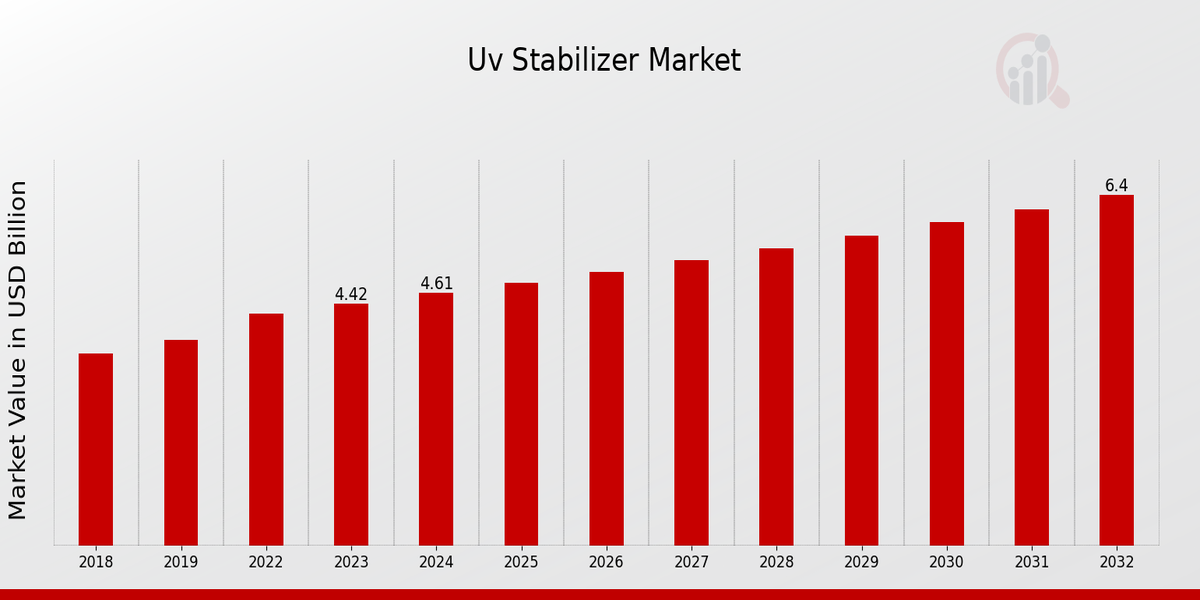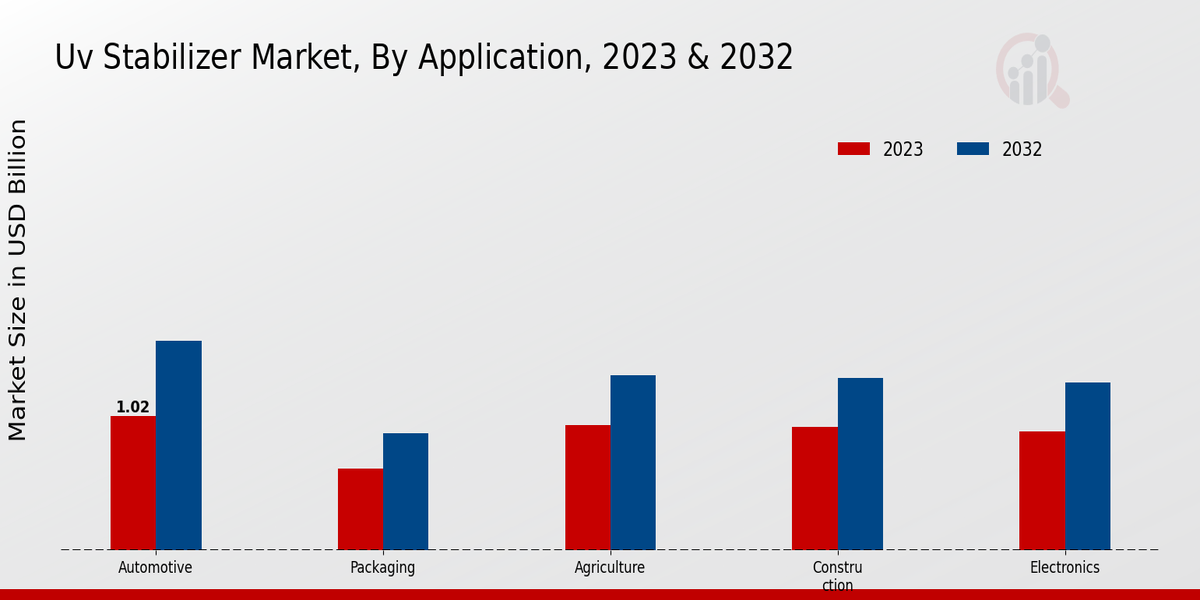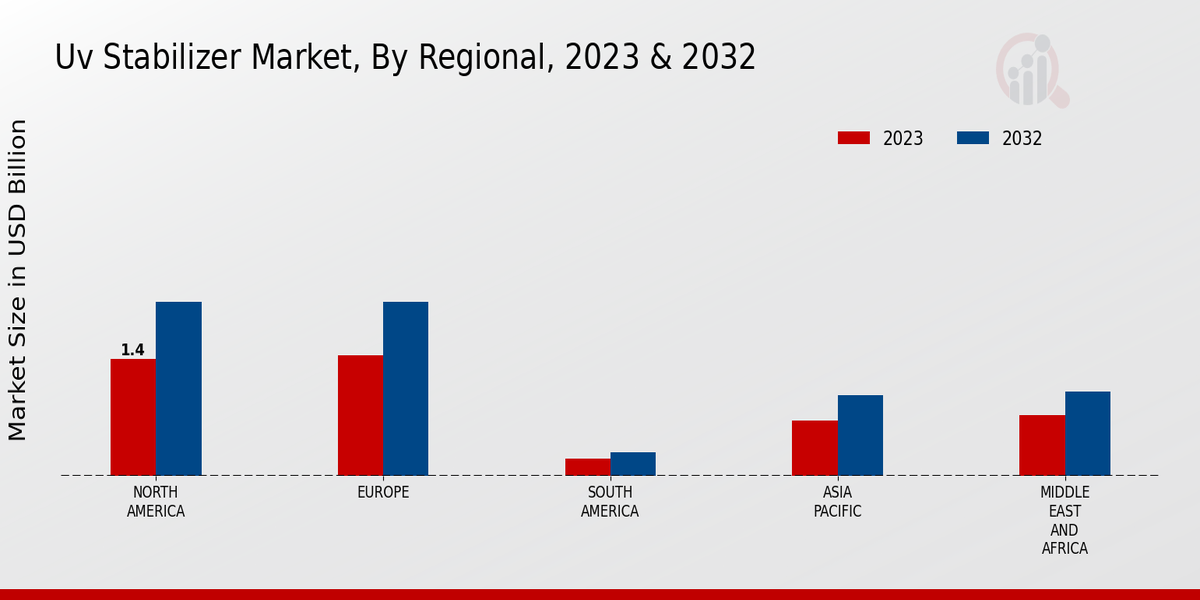Global Uv Stabilizer Market Overview
The UV stabilizer Market Size was estimated at 4.8(USD Billion) in 2024. The Uv Stabilizer Market Industry is expected to grow from 5(USD Billion) in 2025 to 7.26(USD Billion) by 2034. The Uv Stabilizer Market CAGR (growth rate) is expected to be around 4.2% during the forecast period (2025 - 2034).
Key UV Stabilizer Market Trends Highlighted
The UV stabilizer market is witnessing a surge in demand driven by the increasing awareness of the harmful effects of ultraviolet radiation on various materials. Key market drivers include the growing use of UV stabilizers in plastics, coatings, and textiles to enhance their durability and protect them from degradation.Opportunities are emerging in the exploration of advanced UV stabilizers with improved performance and efficiency, as well as the development of eco-friendly and sustainable UV stabilizer solutions. The market is also seeing a trend towards customized UV stabilizer formulations tailored to specific applications and industries.Recent trends in the UV stabilizer market include the adoption of UV stabilizers in new applications such as electronic displays and medical devices. The demand for high-performance UV stabilizers with long-term protection and resistance to extreme weather conditions is also increasing. The market is expected to continue an upward trajectory driven by the growing emphasis on protecting materials from UV damage and the pursuit of innovative and sustainable UV stabilization solutions.
Source: Primary Research, Secondary Research, MRFR Database and Analyst Review
Uv Stabilizer Market Drivers
Rising Demand for UV-resistant plastics
The UV stabilizer market is expanding rapidly, driven by the increasing demand for plastics across automotive, construction, and packaging, among other industries. High exposure light to UV radiation can cause degradation and discoloring of plastics while further leading them to become brittle. This has mandated the UV resistant plastics in plastic industries to increase the durability and performance of the product. Thus, one of the leading factors of the UV stabilizer market is the increasing demand for UV-resistant plastics and the increasing popularity of plastics in the automotive industry, which is open to sunlight exposure for longer durations. With the increasing production of plastics globally, the demand and, thus, the market for UV stabilizers is witnessing a consistent increase.
Stringent Environmental Regulations
The rise of environmental awareness and the tightening of restrictions concerning the use of hazardous substances have pushed manufacturers toward implementing UV stabilizers that are less harmful to the environment. While benzophenones, benzotriazoles, and other known UV stabilizers have already been identified as hazardous for the environment and the health of human beings when exposed, and a replacement for them was needed, the new market trend will result in the accelerated adoption of alternative, less toxic products.The trend appears to be relatively stable as new; stricter regulations are likely to be established by governments across the globe to protect the planet.
Technological Advancements and Innovation
Ongoing advancements in UV stabilizer technology are leading to the development of more efficient and effective products. Researchers are exploring new chemistries and formulations to enhance the performance and versatility of UV stabilizers. These innovations cater to the evolving needs of various industries, such as the development of UV stabilizers specifically designed for use in high-performance plastics or under extreme environmental conditions.The focus on innovation and technological advancements is expected to drive market growth as manufacturers strive to differentiate their products and meet the demands of a dynamic market.
Uv Stabilizer Market Segment Insights
Uv Stabilizer Market Application Insights
The UV Stabilizer Market is segmented on the basis of application, with major applications including automotive, packaging, agriculture, construction, and electronics. The automotive segment is projected to account for the largest share of the market in the coming years, driven by the increasing demand for UV stabilizers in automotive coatings and plastics. The packaging segment is also expected to witness significant growth, owing to the rising demand for UV stabilizers in plastic packaging materials. The agriculture segment is expected to grow steadily, driven by the increasing use of UV stabilizers in agricultural films and greenhouses.The construction segment is also projected to witness steady growth, driven by the growing demand for UV stabilizers in roofing materials and exterior coatings. The electronics segment is expected to grow at a moderate pace, driven by the increasing use of UV stabilizers in electronic devices and components. In terms of market size, the UV stabilizer Market is expected to reach USD 4.8 billion by 2024, growing at a CAGR of 4.5% from 2023 to 2024. The Asia-Pacific region is expected to be the largest market for UV stabilizers, followed by Europe and North America.The growing demand for UV stabilizers in emerging economies is expected to drive the growth of the market in the coming years. Key industry players in the UV stabilizer Market include BASF SE, Clariant AG, Evonik Industries AG, and Solvay SA. These companies are investing in research and development to develop new and innovative UV stabilizer products and solutions. 
Source: Primary Research, Secondary Research, MRFR Database and Analyst Review
Uv Stabilizer Market End-Use Insights
The UV stabilizer Market is segmented based on end-uses into Plastic, Textiles, Rubber, Coatings, and Food. The plastic segment dominated the market by generating a revenue share of over 40% in 2023. The demand for UV stabilizers in this segment has been increasing due to the expanding application list of stabilizers within the automotive, construction, and packaging industries. The textiles segment is anticipated to have the highest growth rate due to the increasing use of UV stabilizers in outdoor fabric, awnings, parking umbrellas, tarpaulin, and sunshade production.Rubber segment growth is also anticipated to be constant due to the increasing demand within tire, hose, belt, and other rubber product manufacturing. The coatings segment growth is anticipated to be moderate as the demand for UV stabilizers production in paint, inks, and coatings is used in domestic, automotive, industrial, and special-purpose applications. The food segment growth rate is expected to be constant as the demand for UV stabilizers and absorbers in the production process of packaging used for food products increases.
Uv Stabilizer Market Chemistry Insights
The UV Stabilizer Market is segmented by chemistry into Benzotriazoles (BTZs), Hydroxybenzophenones (HBPs), Benzophenones (BPs), Triazines, and Hindered Amine Light Stabilizers (HALS). Among these, BTZs held the largest market share in 2023, accounting for over 35% of the revenue. The growth of the BTZs segment can be attributed to their excellent UV absorption properties, low volatility, and compatibility with a wide range of polymers. HALS is projected to witness the fastest growth during the forecast period, owing to its superior performance in outdoor applications and increasing adoption in the automotive industry.
Uv Stabilizer Market Physical Form Insights
The UV Stabilizer Market is segmented based on physical form into liquids, powder, granules, and pellets. Among these, the liquids segment held the largest market share in 2023, accounting for around 40% of the UV stabilizer Market revenue. The growth of this segment can be attributed to the ease of application of liquid UV stabilizers, as they can be easily incorporated into various formulations. The powder segment is expected to witness significant growth over the forecast period, owing to its high stability and cost-effectiveness.Powder UV stabilizers are commonly used in the production of plastics, coatings, and adhesives. Granules and pellets are other important physical forms of UV stabilizers. Granules are typically used in the manufacturing of thermoplastics, while pellets are commonly employed in the production of thermoset plastics. The demand for granules and pellets is expected to remain steady over the coming years, driven by the increasing adoption of plastics in various industries.
Uv Stabilizer Market Regional Insights
The UV stabilizer Market is segmented into North America, Europe, APAC, South America, and MEA. Among these regions, North America and Europe are the largest markets for UV stabilizers, accounting for over 50% of the market revenue in 2023. The growth in these regions is primarily driven by the increasing demand for UV stabilizers in the automotive and construction industries. APAC is expected to witness the fastest growth over the forecast period, owing to the rising demand for UV stabilizers in the packaging and agricultural industries in countries such as China, India, and Japan.South America and MEA are expected to experience moderate growth, driven by the growing construction and automotive industries in these regions. 
Source: Primary Research, Secondary Research, MRFR Database and Analyst Review
Uv Stabilizer Market Key Players And Competitive Insights
Major players in the UV stabilizer Market industry are constantly striving to develop innovative products and technologies to gain a competitive edge. Leading UV stabilizer Market players are focusing on expanding their presence and establishing strategic partnerships to strengthen their market position. The UV stabilizer Market is characterized by intense competition, with key players investing heavily in research and development to differentiate their offerings. The competitive landscape is expected to remain dynamic, with new entrants and disruptive technologies emerging in the future. To stay competitive, companies are focusing on providing customized solutions, implementing sustainable practices, and leveraging digital technologies to enhance their offerings and customer experiences.A leading company in the UV stabilizer Market is BASF, a German multinational chemical company. BASF offers a wide range of UV stabilizer products under its Tinuvin and Uvinul brands. The company has a strong presence and a reputation for producing high-quality UV stabilizers. BASF is committed to sustainability and has implemented various initiatives to reduce its environmental impact. The company has also invested in research and development to develop new and innovative UV stabilizer products.A major competitor in the UV stabilizer Market is Clariant, a Swiss multinational specialty chemicals company. Clariant offers a portfolio of UV stabilizer products under its Hostavin and Licocene brands. The company has a presence and a strong customer base in various industries. Clariant is focused on providing customized solutions and has developed a range of UV stabilizer products to meet specific customer requirements. The company is also committed to sustainability and has implemented various initiatives to reduce its environmental impact.
Key Companies in the UV stabilizer Market Include
Uv Stabilizer Market Industry Developments
The UV stabilizer market is projected to reach USD 6.4 billion by 2032, exhibiting a CAGR of 4.2% from 2024 to 2032. Rising demand for UV stabilizers in plastics and coatings industries, coupled with growing awareness about UV protection, is driving market growth. The increasing use of plastics in automotive, construction, and packaging applications is fueling demand for UV stabilizers to enhance the durability and longevity of these materials. Furthermore, stringent regulations on the use of hazardous chemicals are endorsing the adoption of eco-friendly UV stabilizers. The Asia-Pacific region is expected to hold a significant market share due to the presence of major plastics and coatings manufacturers.Recent developments in the UV stabilizer market include the launch of new products and technologies. For instance, BASF introduced Tinuvin XT 300, a new UV stabilizer specifically designed for polyolefin applications. Evonik also expanded its UV stabilizer portfolio with the launch of UV-340, a highly effective UV stabilizer for polyamides. These advancements are enhancing the performance and durability of plastics and coatings, contributing to the growth of the UV stabilizer market.
Uv Stabilizer Market Segmentation Insights
Uv Stabilizer Market Application Outlook
-
Automotive
-
Packaging
-
Agriculture
-
Construction
-
Electronics
UV Stabilizer Market End-Use Outlook
-
Plastic
-
Textiles
-
Rubber
-
Coatings
-
Food
Uv Stabilizer Market Chemistry Outlook
UV Stabilizer Market Physical Form Outlook
-
Liquids
-
Powder
-
Granules
-
Pellets
UV Stabilizer Market Regional Outlook
-
North America
-
Europe
-
South America
-
Asia Pacific
-
Middle East and Africa
| Report Attribute/Metric |
Details |
| Market Size 2024 |
4.8(USD Billion) |
| Market Size 2025 |
5(USD Billion) |
| Market Size 2034 |
7.26(USD Billion) |
| Compound Annual Growth Rate (CAGR) |
4.2% (2024 - 2032) |
| Report Coverage |
Revenue Forecast, Competitive Landscape, Growth Factors, and Trends |
| Base Year |
2024 |
| Market Forecast Period |
2025 - 2034 |
| Historical Data |
2020 - 2024 |
| Market Forecast Units |
USD Billion |
| Key Companies Profiled |
Chemtura, IGM Resins, Croda, Jiangsu Sainuo Fine Chemicals, SONGWON, Albemarle, Evonik, BASF, SABIC, Dongguan Huafeng Additives, LuXing, Clariant, ADEKANewparaLANXESS |
| Segments Covered |
Application, End-Use, Chemistry, Physical Form, Regional |
| Key Market Opportunities |
Increasing demand in the automotive industry Growing popularity of UV stabilizers in agricultural films. Rising demand from the construction sector Growing awareness of UV protection in personal care products Expansion of the packaging industry. |
| Key Market Dynamics |
Increasing demand for plastics, growing awareness of UV degradation, stringent regulations, technological advancements, expanding applications in automotive and building amp construction |
| Countries Covered |
North America, Europe, APAC, South America, MEA |
Frequently Asked Questions (FAQ) :
The UV stabilizer market is currently valued at approximately USD 4.42 billion in 2023.
The UV stabilizer market is projected to grow at a CAGR of 4.2% from 2025 to 2034.
North America held the largest market share in 2023 and is expected to maintain its dominance during the forecast period.
Major applications of UV stabilizers include plastics, coatings, and personal care products.
Key competitors in the UV stabilizer market include BASF, Clariant, Songwon, and Evonik.
Major growth drivers of the UV stabilizer market include increasing demand for plastics, rising awareness about the harmful effects of UV radiation, and stringent environmental regulations.
Challenges faced by the UV stabilizer market include fluctuating raw material prices and intense competition.
Key trends in the UV stabilizer market include the development of eco-friendly UV stabilizers and the growing demand for UV stabilizers in emerging economies.
The UV stabilizer market is projected to reach a value of approximately USD 6.4 billion by 2032.
Major factors influencing the growth of the UV stabilizer market include the increasing demand for plastics, rising awareness about the harmful effects of UV radiation, and stringent environmental regulations.

















